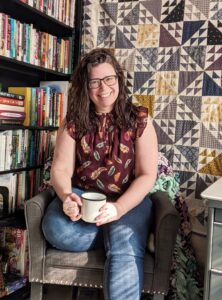UW-Stevens Point
Assistant Professor
English
Erica Ringelspaugh is a University of Wisconsin-Stevens Point Assistant Professor. She loves working with the students who are learning to be English teachers and talking education, classrooms, curriculum, and grading theory with them. She models what she teaches them to do and has them being silly, working in stations, reading aloud, recommending books to each other, drawing, acting, and writing to show their analysis of literature, as well as lots of group development work and engaging in educational theory. She still misses teaching high school.
Dr. Ringelspaugh taught high school English Language Arts for 11 years in Adams-Friendship, Wisconsin before coming to UWSP. As a high school teacher, she taught a variety of classes to students in all four high school grades. She served on her school and district leadership teams, was an Educator Effectiveness coach, and advised student groups. One year, she even coached JVR volleyball, which she should not have done because she never played volleyball; they were clearly desperate.
Ringelspaugh earned her Masters in Teaching and Learning through St. Mary’s University of Minnesota in 2009, with a thesis about grading theory, her admin and curriculum licenses through Viterbo University in LaCrosse in 2015, and her Ed.D. through Edgewood College in Madison in 2021, with a dissertation about novice teachers in rural schools implementing critical literacy.
Ringelspaugh loves to read, walk, ride her bike, lie in the sun like a cat, and laugh with friends. She is terrified of tornadoes and eats too much popcorn. She is dorky enough to keep a reader’s notebook year round to model for her students what they should do with their students. She is the mom of two smallish humans.
Teaching and Learning Philosophy
Education can be the great equalizer, leveling playing fields and providing students with diverse opportunities. Classrooms can be a sanctuary, a community where everyone comes together to learn and no one gets left behind.
All students can and will learn in my classroom. In each class, I foster a community of learners who trust each other. We begin the first day of class with opening community building and continue through the semester with regular partner and group collaboration. Students work with some consistent partners and some new partners each class period to learn from new people and build relationships that support their learning. I try to create classroom spaces where students are physically and emotionally safe, where they feel ready to take academic risks in a supportive community.
From there, I plan a rigorous curriculum, using backwards design to create quality learning activities, provide targeted feedback, model academic skills and dispositions, and use criterion-based assessments to determine accurate grades. Students are engaged in relevant, authentic reading, writing, thinking and design and can tailor the learning to their own interests and strengths. I believe that, like children, we learn the most naturally through play and constructivism, so I use learning activities that ask students to practice academic skills in creative ways, like ranking the effectiveness of thesis statements, writing dialogue with Calvin and Hobbes comic strips, drawing a motif mural on the classroom chalkboard, and participating in learning goal relay races. I know learning happens at different rates for different students and that learning is cumulative over time, so formative assessment, reflection and continuous metacognition about students’ own learning is so important to guide our work in the classroom. While I plan the course learning arc, we all learn together, because I know that my students have funds of knowledge and things to teach me, too, and so we process the course materials differently in each section and iteration of the course.
Activities and learning in the classroom is designed specifically for the students in front of me: I am a culturally sustaining and inclusive practitioner. I use inclusive language, find models of reading, writing, and teaching from people of various backgrounds and identities, and design learning activities and assessments that build on student’s home cultures. All students should be able to see themselves in the course materials.
It’s my joy to hang out in classrooms with students, my honor to walk alongside them on their learning journey, and my pleasure to watch them learn and to learn with them. It’s good to be a teacher.

